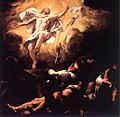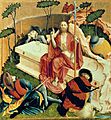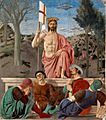Resurrection of Jesus facts for kids

In the New Testament, Jesus is crucified, dies, is buried within a tomb, and resurrected three days later. (See Gospel of Matthew chapters 27-28) Jesus is the son of God.(Gospel of Mark 1:1)
The resurrection of Jesus, or anastasis is the Christian belief that God raised Jesus after his crucifixion as first of the dead, starting his exalted life as Christ and Lord. In Christian theology, the death and resurrection of Jesus are the most important events, a foundation of the Christian faith, and commemorated by Easter. His resurrection is the guarantee that all the Christian dead will be resurrected at Christ's parousia. For the Christian tradition, the bodily resurrection was the restoration to life of a transformed body powered by spirit, as described by Paul and the Gospels, that led to the establishment of Christianity.
In secular and liberal Christian scholarship, the appearances of Jesus are explained as visionary experiences that gave the impetus to the belief in the exaltation of Jesus and a resumption of the missionary activity of Jesus' followers.
Jewish–Hellenistic background
Jewish
The idea of any resurrection at all first emerges clearly in the 2nd-century BC Book of Daniel, but as a belief in the resurrection of the soul alone. Josephus tells of the three main Jewish sects of the 1st century AD, that the Sadducees held that both soul and body perished at death; the Essenes that the soul was immortal but the flesh was not; and the Pharisees that the soul was immortal and that the body would be resurrected to house it. Of these three positions, Jesus and the early Christians appear to have been closest to that of the Pharisees. Steve Mason notes that for the Pharisees, "the new body is a special, holy body," which is different from the old body, "a view shared to some extent by the ex-Pharisee Paul (1. Cor. 15:35ff)."
Endsjø notes that the evidence from Jewish texts and from tomb inscriptions points to a more complex reality. For example, when the 2nd century BC author the Book of Daniel wrote that "many of those sleeping in the dust shall awaken" (12:2), he probably had in mind rebirth as stars in God's Heaven, stars having been identified with angels from early times – such a rebirth would rule out a bodily resurrection, as angels were believed to be fleshless. Other texts range from the traditional Old Testament view that the soul would spend eternity in the underworld, to a metaphorical belief in the raising of the spirit. Most avoided defining what resurrection might imply, but a resurrection of the flesh was a marginal belief.
Images for kids
-
Resurrection of Jesus Christ (Kinnaird Resurrection) by Raphael, 1502
-
Resurrection of Christ, Noël Coypel, 1700, using a hovering depiction of Jesus
-
Right wing of the winged triptych at the Church of the Teutonic Order, Vienna, Austria. The artwork depicts Christ's crucifixion and burial (left), and resurrection (right).
-
A rotunda in Church of the Holy Sepulchre, called the Anastasis ("Resurrection"), which contains the remains of a rock-cut room that Helena and Macarius identified as the burial site of Jesus.
-
Resurrection of Christ, by Hans Memling, 15th century
-
Resurrection, by Dieric Bouts, c. 1450–1460
-
Der Auferstanden, by Lucas Cranach, 1558
-
Piero della Francesca, 15th century
-
The Resurrection (La Résurrection) – James Tissot, c. 1890, Brooklyn Museum
-
Women at the empty tomb, by Fra Angelico, 1437–1446
See also
 In Spanish: Resurrección de Jesús para niños
In Spanish: Resurrección de Jesús para niños




















